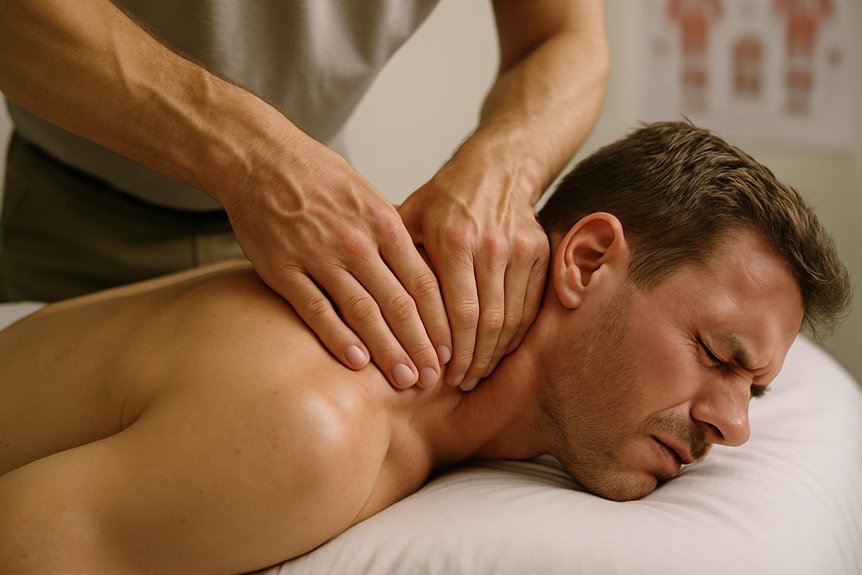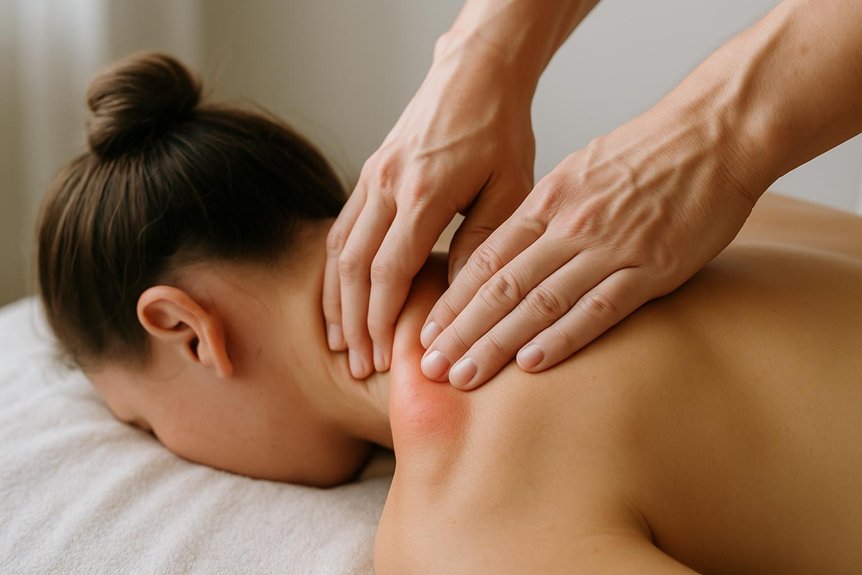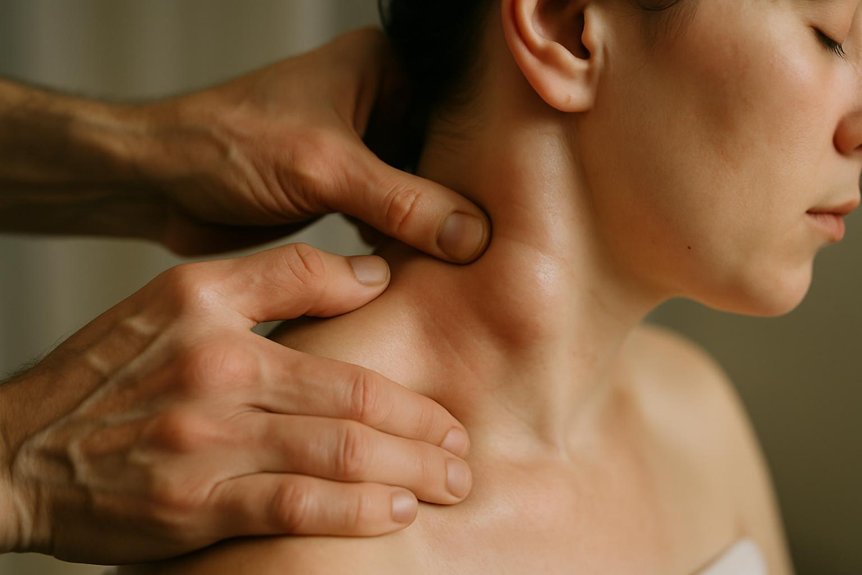It can sometimes result in mild, temporary swelling of lymph nodes. This occurs as the massage stimulates lymphatic circulation, supporting detoxification and immune response. Such swelling is generally a normal, self-limiting reaction due to increased tissue waste removal and fluid movement. The swelling typically resolves within a few days and is not usually cause for concern. Those interested in learning about normal post-massage responses and when to seek further advice can find additional guidance ahead.
Understanding Deep Tissue Massage and Its Effects

It applies sustained, targeted pressure to deeper layers of muscle and connective tissue.
This technique, utilised by Spa & Massage therapists, aims to alleviate myofascial restrictions, reduce chronic muscle tension, and improve joint mobility.
Enhanced blood flow supports oxygen delivery and metabolic waste removal, while mechanical pressure assists in dislodging adhesions.
The lymphatic system benefits indirectly as muscular compression facilitates interstitial fluid movement, contributing to decreased oedema and improved tissue health.
Clients may experience a gentle release of tension and a heightened sense of bodily awareness.
At Spa & Massage, each session is tailored to the client’s unique presentation, ensuring that therapeutic intensity remains both effective and nurturing within a safe, respectful environment.
Relaxation and healing can also be supported when elements from aromatherapy massage are included, further enhancing the calming effects of deep tissue work.
The Role of the Lymphatic System During Massage
The lymphatic system plays a central role in fluid regulation and immune defense by transporting lymph throughout the body.
During therapeutic massage, including techniques employed at Spa & Massage, manual pressure facilitates lymphatic flow and supports the removal of metabolic waste.
Optimizing lymphatic circulation through massage may contribute to enhanced immune function and overall client well-being.
Lymphatic System Basic Functions
While often overlooked, the lymphatic system plays a vital role in maintaining immune function and fluid balance within the body. This intricate network of vessels, nodes, and lymphatic organs transports lymph—a clear fluid containing white blood cells—throughout tissues.
Its primary function is to remove interstitial fluid, filter pathogens, and facilitate immune surveillance. Lymph nodes act as filtration units, trapping bacteria, debris, and abnormal cells before lymph is returned to the bloodstream.
At Spa & Massage, therapists recognise that ideal lymphatic function supports overall wellbeing and resilience. Understanding the system’s essential role, therapists tailor each session to respect the body’s natural defences and encourage healthy physiological responses.
This evidence-based approach ensures that every treatment complements the body’s innate mechanisms for maintaining health and equilibrium.
Massage and Fluid Movement
Through targeted manual techniques, massage therapy can substantially influence fluid dynamics within the body. In the clinical setting at Spa & Massage, therapists employ precise pressure and rhythmic movements designed to mobilize interstitial fluid and enhance lymphatic flow.
This process assists in the removal of metabolic waste and reduces localized edema, fostering a sense of lightness and renewed importance for clients. Gentle stimulation of lymphatic vessels during massage encourages the efficient drainage of excess fluid, while also supporting tissue homeostasis.
Clients frequently report a noticeable decrease in swelling or tension following treatment, reflecting the beneficial impact on their fluid balance. The approach used by Spa & Massage therapists prioritizes both safety and efficacy, ensuring that each technique is tailored to individual needs while respecting the natural function of the lymphatic system.
Supporting Immune Health
As immune function depends heavily on the integrity of the lymphatic system, targeted massage techniques have been shown to facilitate lymphatic circulation and thereby support overall immune surveillance.
In practice at Spa & Massage, therapists employ carefully modulated pressure and directional strokes to stimulate lymphatic flow, encouraging the removal of metabolic waste and cellular debris.
This process assists in optimizing the body’s innate defense mechanisms, enhancing the capacity to recognize and respond to pathogens efficiently.
Clients often report a sensation of lightness and improved strength following sessions that address lymphatic health.
Evidence supports that manual therapies, when performed by experienced professionals, can augment lymph transport and reduce stagnation.
Can It Lead to Swollen Lymph Nodes?

Occasionally, clients may wonder whether it can cause swollen lymph nodes. From a clinical perspective, it involves targeted pressure applied to deeper muscle layers and connective tissues, which can increase local circulation and stimulate lymphatic flow.
At Spa & Massage, therapists are trained to recognize anatomical landmarks and avoid excessive pressure over lymph nodes, reducing the risk of lymphatic irritation. While mild swelling may occur temporarily due to increased lymph movement, clinically significant lymphadenopathy is uncommon following professionally administered massage.
Evidence suggests that any transient swelling is usually benign and self-limiting. Clients are encouraged to communicate any discomfort or unusual swelling after treatment, allowing therapists to tailor future sessions to individual sensitivities and promote an ideal, nurturing experience.
When Swelling Is a Normal Response
Following deep tissue massage, mild swelling of lymph nodes can occur as a result of natural lymphatic stimulation and the body’s healing response.
This temporary inflammatory reaction is generally considered normal and reflects increased activity within the lymphatic system.
Spa & Massage therapists monitor client feedback closely to distinguish between expected post-treatment effects and signs that may require further assessment.
Natural Lymphatic Stimulation
When the body undergoes this therapy, localized swelling of lymph nodes can occur as a physiological response to increased lymphatic activity. This reaction is typically a sign that the lymphatic system is being naturally stimulated, promoting the mobilization and filtration of interstitial fluids.
At Spa & Massage, therapists utilize targeted techniques designed to encourage lymphatic drainage, supporting the body’s intrinsic detoxification processes.
Clinical observations confirm that temporary lymph node swelling is generally benign and correlates with enhanced circulation and the removal of metabolic waste.
Clients who receive this massage often report a sense of lightness and fluidity, reflecting this natural process.
In most cases, such swelling resolves spontaneously, signifying the lymphatic system’s healthy adaptation to therapeutic touch and increased physiological demand.
Body’s Healing Response
Although transient swelling of lymph nodes may develop after a massage, this response typically reflects the body’s natural healing mechanisms. Lymphatic tissues often react to increased circulation and the mobilization of metabolic byproducts during therapeutic interventions.
In Spa & Massage clinics, therapists recognize that mild, short-term lymph node swelling can be a sign of the immune system processing cellular waste and facilitating tissue repair. This phenomenon is generally self-limiting and not indicative of pathology.
Clients are advised to observe their body’s signals, ensuring adequate hydration and rest post-session to support ideal lymphatic function.
At Spa & Massage, practitioners closely monitor client feedback, tailoring aftercare recommendations to each individual’s needs, reinforcing trust and supporting the body’s restorative processes through evidence-based practices.
Temporary Inflammatory Reaction
As it stimulates underlying musculature and connective tissues, a temporary inflammatory reaction may occur, manifesting as mild swelling of nearby lymph nodes. This response is a normal physiological process, reflecting the body’s natural mechanism for managing localized tissue stress and promoting healing.
In clinical practice at Spa & Massage, therapists often reassure clients that such swelling is typically transient and should subside within a few days. The lymphatic system works to clear metabolic byproducts released during massage, occasionally resulting in brief lymph node enlargement.
Monitoring symptoms and practicing recommended aftercare, such as adequate hydration and gentle movement, can support ideal recovery. Should swelling persist or be accompanied by discomfort, Spa & Massage therapists advise clients to consult a healthcare provider for further evaluation.
How Our Therapists Minimise the Risk of Lymph Node Swelling

Professional vigilance guides every session at Spa & Massage, where therapists employ evidence-based protocols to minimise the risk of lymph node swelling during massage session.
Each treatment begins with a thorough consultation, allowing therapists to assess for contraindications and adapt techniques accordingly.
Precise anatomical knowledge ensures that pressure is carefully modulated around lymphatic structures, particularly in regions such as the neck, axillae, and groin.
Therapists at Spa & Massage utilise slow, controlled strokes and avoid sustained, excessive force over lymph nodes.
Client feedback is actively solicited throughout the session, fostering a responsive and tailored experience.
Steps to Take If You Experience Swollen Lymph Nodes After Massage
Despite rigorous preventive measures undertaken by therapists at Spa & Massage, some individuals may still notice swelling of lymph nodes following a remedial massage.
In such cases, clinical best practice involves monitoring the affected area for changes in size, tenderness, or warmth.
Application of a cool compress may alleviate discomfort. Hydration is encouraged to support lymphatic circulation.
Clients are advised to avoid vigorous physical activity and additional massage until swelling subsides.
If lymph node enlargement persists beyond several days, or if symptoms such as fever, redness, or pain intensify, prompt consultation with a healthcare provider is recommended.
Spa & Massage therapists value client comfort and encourage open communication regarding any post-treatment concerns, ensuring ongoing support and personalised aftercare throughout the client’s wellness journey.
Conclusion
In conclusion, while intensive tissue massage may occasionally contribute to temporary lymph node swelling, this response is typically mild and self-limiting, much like a ripple fading across calm water. Evidence suggests that with trained therapists and appropriate aftercare, the risk remains minimal. Clients are encouraged to communicate openly with practitioners and monitor post-treatment changes. Prioritising individual health profiles ensures that the therapeutic benefits of this massage therapy can be safely and effectively enjoyed.



